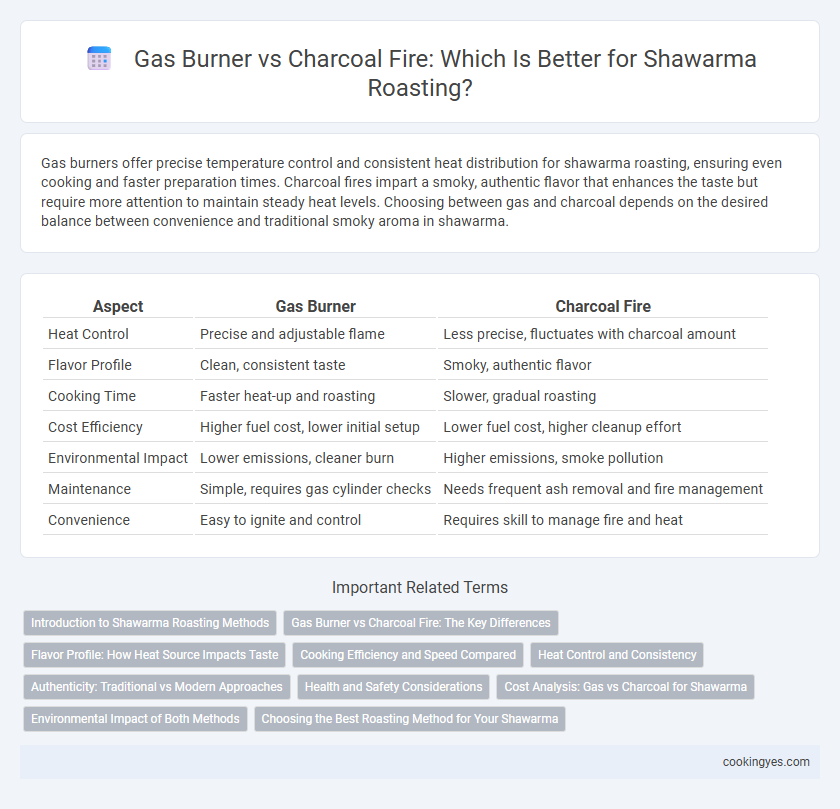Gas burners offer precise temperature control and consistent heat distribution for shawarma roasting, ensuring even cooking and faster preparation times. Charcoal fires impart a smoky, authentic flavor that enhances the taste but require more attention to maintain steady heat levels. Choosing between gas and charcoal depends on the desired balance between convenience and traditional smoky aroma in shawarma.
Table of Comparison
| Aspect | Gas Burner | Charcoal Fire |
|---|---|---|
| Heat Control | Precise and adjustable flame | Less precise, fluctuates with charcoal amount |
| Flavor Profile | Clean, consistent taste | Smoky, authentic flavor |
| Cooking Time | Faster heat-up and roasting | Slower, gradual roasting |
| Cost Efficiency | Higher fuel cost, lower initial setup | Lower fuel cost, higher cleanup effort |
| Environmental Impact | Lower emissions, cleaner burn | Higher emissions, smoke pollution |
| Maintenance | Simple, requires gas cylinder checks | Needs frequent ash removal and fire management |
| Convenience | Easy to ignite and control | Requires skill to manage fire and heat |
Introduction to Shawarma Roasting Methods
Shawarma roasting methods primarily involve gas burners and charcoal fires, each influencing flavor and cooking efficiency. Gas burners offer consistent heat control and faster cooking times, making them ideal for high-volume commercial use. Charcoal fires impart a distinctive smoky aroma and rich taste, enhancing the traditional shawarma experience preferred by many aficionados.
Gas Burner vs Charcoal Fire: The Key Differences
Gas burners provide consistent and easily controllable heat for shawarma roasting, ensuring uniform cooking and faster preparation. Charcoal fires impart a distinctive smoky flavor and aroma that enhance the traditional taste of shawarma but require more attention to maintain optimal temperature. The choice between gas and charcoal depends on priorities such as flavor authenticity, cooking speed, and operational convenience.
Flavor Profile: How Heat Source Impacts Taste
Gas burners provide consistent, controllable heat that results in evenly cooked shawarma with a clean and slightly sweet flavor profile, highlighting the natural spices and marination. Charcoal fire imparts a smoky, rich aroma and deeper charred notes, enhancing the shawarma's complexity and traditional taste. The choice between gas and charcoal directly influences the intensity of smokiness and overall flavor depth in the roasted shawarma.
Cooking Efficiency and Speed Compared
Gas burners provide consistent and controllable heat, resulting in faster cooking times for shawarma compared to charcoal fire. Charcoal fire imparts a distinct smoky flavor but requires longer preheating and slower roasting speeds, impacting cooking efficiency. For high-volume shawarma preparation, gas burners optimize speed and energy use, while charcoal suits artisanal, flavor-focused cooking.
Heat Control and Consistency
Gas burners provide precise heat control for shawarma roasting, allowing consistent temperature adjustment to ensure even cooking and avoid burning. Charcoal fires offer a unique smoky flavor but present challenges in maintaining steady heat, leading to potential temperature fluctuations and uneven roasting. For consistent results, gas burners are preferred in professional settings, while charcoal remains popular for its traditional aroma despite less predictable heat control.
Authenticity: Traditional vs Modern Approaches
Charcoal fire roasting infuses shawarma with a distinct smoky aroma and authentic flavor profile that mirrors traditional Middle Eastern preparation methods. Gas burners offer precise temperature control and consistency, appealing to modern efficiency but often lack the nuanced taste imparted by charcoal smoke. Enthusiasts of classic shawarma prioritize charcoal roasting to preserve the cultural heritage and genuine sensory experience tied to the dish's origin.
Health and Safety Considerations
Gas burners for shawarma roasting offer more consistent heat control, reducing the risk of uneven cooking and potential bacterial growth, which enhances food safety. Charcoal fire imparts a distinct smoky flavor but produces higher levels of harmful emissions such as polycyclic aromatic hydrocarbons (PAHs) and carbon monoxide, posing greater health risks for both cooks and consumers. Proper ventilation and regular equipment maintenance are essential to minimize safety hazards regardless of the heat source used in shawarma preparation.
Cost Analysis: Gas vs Charcoal for Shawarma
Gas burners offer consistent heat control and lower fuel costs, making them more economical for high-volume shawarma roasting compared to charcoal, which requires frequent replenishment and higher fuel expenses. Charcoal imparts a distinct smoky flavor but demands longer roasting times, increasing labor costs and reducing overall efficiency. Evaluating total operational expenses, gas combustion stands out for cost savings and faster cooking cycles in commercial shawarma production.
Environmental Impact of Both Methods
Gas burners used for shawarma roasting produce fewer particulate emissions compared to charcoal fires, resulting in lower air pollution and reduced carbon footprint. Charcoal combustion releases higher levels of carbon monoxide and volatile organic compounds, contributing significantly to local smog and deforestation concerns. Choosing gas burners over charcoal aligns with environmentally sustainable practices by minimizing greenhouse gas emissions and preserving natural resources.
Choosing the Best Roasting Method for Your Shawarma
Gas burner roasting offers precise temperature control and consistent heat distribution, ensuring evenly cooked shawarma with minimal flare-ups. Charcoal fire imparts a distinctive smoky flavor and traditional aroma, enhancing the meat's taste but requires careful monitoring to avoid uneven cooking or charring. Selecting the best roasting method depends on balancing flavor preference with cooking consistency and efficiency for optimal shawarma quality.
Gas burner vs Charcoal fire for Shawarma roasting Infographic

 cookingyes.com
cookingyes.com